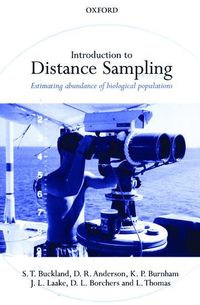
endast ny
Introduction to Distance Sampling
This book introduces the suite of techniques known as 'distance sampling', so-called because the common theme is the sampling of distances of objects from a line or point. The objects are usually animals or groups of animals ('clusters'), and the primary aim is to estimate their density or abundance in a survey area. In line transect sampling, the sampled distances are the shortest or perpendicular distance from a detected object to the line. It is the most widelyused method for assessing the abundance of a wide range of terrestrial and marine animals. In point transect sampling, distances of detected objects from the sampled points are recorded. This book provides a comprehensive introduction to both techniques, and also describes several relatedtechniques.'Introduction to Distance Sampling' updates the 1993 book 'Distance Sampling', which was the first, and until now, only book devoted to the topic. The book is aimed at quantitative biologists and wildlife managers, and statisticians involved in wildlife monitoring programmes. Of particular significance in this update is the chapter on study design and field methods, which has been extensively rewritten and extended. New technologies such as laser range finders, theodolites and theGeographical Positioning System (GPS) are discussed, and advice is given on a wide range of survey methods. Analysis methods have also been generalized, through the use of various types of multiplier. Many exercises have been introduced, to make the book more useful to graduate students in wildlife andconservation management.
Utgiven: 2001
ISBN: 9780198509271
Förlag: OUP Oxford
Format: Häftad
Språk: Engelska
Sidor: 448 st
This book introduces the suite of techniques known as 'distance sampling', so-called because the common theme is the sampling of distances of objects from a line or point. The objects are usually animals or groups of animals ('clusters'), and the primary aim is to estimate their density or abundance in a survey area. In line transect sampling, the sampled distances are the shortest or perpendicular distance from a detected object to the line. It is the most widelyused method for assessing the abundance of a wide range of terrestrial and marine animals. In point transect sampling, distances of detected objects from the sampled points are recorded. This book provides a comprehensive introduction to both techniques, and also describes several relatedtechniques.'Introduction to Distance Sampling' updates the 1993 book 'Distance Sampling', which was the first, and until now, only book devoted to the topic. The book is aimed at quantitative biologists and wildlife managers, and statisticians involved in wildlife monitoring programmes. Of particular significance in this update is the chapter on study design and field methods, which has been extensively rewritten and extended. New technologies such as laser range finders, theodolites and theGeographical Positioning System (GPS) are discussed, and advice is given on a wide range of survey methods. Analysis methods have also been generalized, through the use of various types of multiplier. Many exercises have been introduced, to make the book more useful to graduate students in wildlife andconservation management.
Ny bok
1104 kr1162 kr
5% studentrabatt med Studentapan
Begagnad bok (0 st)
Varje vecka tillkommer tusentals nya säljare. Bevaka boken så får du meddelande när den finns tillgänglig igen.



